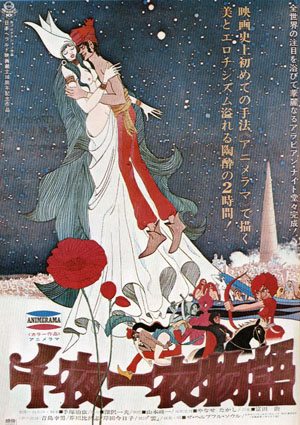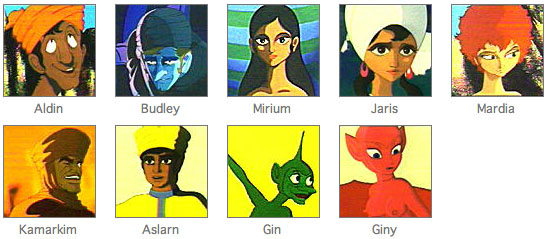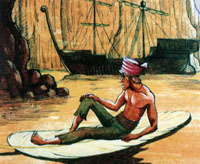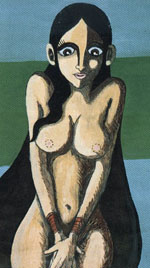
In the 1960s Osamu Tezuka’s Mushi Productions was one of the leading producers of TV animation in Japan. Three of his Mushi series had been sold to American children’s television: Astro Boy (1963), Kimba the White Lion (1965), and The Amazing 3 (1966). In addition, Tezuka was the author of Ambassador Magma in 1965, intended as a TV cartoon series, but when it failed to sell, Tezuka sold the story to P Productions to become a live-action TV series. It became a U.S. children’s series known as The Space Giants in 1970.
These were all children’s programs. But Tezuka, a fan of animation in all forms, was concerned by animation’s reputation as being for children only. He wanted to show that animation could be for all age groups and all interests. In the late 1960s he determined to produce theatrical animation features that would obviously be for adults rather than for children. These would be erotic but in good taste; the animated equivalent of America’s Playboy magazine. All of Mushi Pro’s resources would be behind them – with mixed results.
 The first was Tezuka’s “千夜一夜物語, Senya Ichya Monogatori or A Thousand and One Nights”. This was advertised as in “Animerama”, a series of Mushi Pro theatrical features specifically for adults. It was released on June 14, 1969; distributed by the national Nippon Herald Films as a 10th anniversary feature. It was a whopper at two hours and almost eleven minutes. Tezuka threw Mushi Pro’s top people into it. The director was Eichi Yamamoto and the music by Isao Tomita (with a lot of help from Alexander Borodin’s 19th-century romantic scores), both of whom performed the same roles for Kimba the White Lion. The orchestra was conducted by Seiji Yokoyama, who would later compose the memorable operatic-quality music for Space Pirate Captain Harlock; also the delightful music for Tōei Dōga’s TV movie adaptation of Marvel Comics’ Tomb of Dracula. The Art Director was Osamu Dezaki, later the famous director of much anime; and the Character Designer was Takashi Yanase, who would later direct Sanrio’s disastrous Metamorphoses. The production staff was claimed to have been increased to a staggering 60,000 people (although I don’t think that anyone believed that). Tezuka invited several prominent Japanese authors, especially science-fiction writers like Sakyo Komatsu and Yasutaka Tsutsui, to have fun as the voice actors of minor characters.
The first was Tezuka’s “千夜一夜物語, Senya Ichya Monogatori or A Thousand and One Nights”. This was advertised as in “Animerama”, a series of Mushi Pro theatrical features specifically for adults. It was released on June 14, 1969; distributed by the national Nippon Herald Films as a 10th anniversary feature. It was a whopper at two hours and almost eleven minutes. Tezuka threw Mushi Pro’s top people into it. The director was Eichi Yamamoto and the music by Isao Tomita (with a lot of help from Alexander Borodin’s 19th-century romantic scores), both of whom performed the same roles for Kimba the White Lion. The orchestra was conducted by Seiji Yokoyama, who would later compose the memorable operatic-quality music for Space Pirate Captain Harlock; also the delightful music for Tōei Dōga’s TV movie adaptation of Marvel Comics’ Tomb of Dracula. The Art Director was Osamu Dezaki, later the famous director of much anime; and the Character Designer was Takashi Yanase, who would later direct Sanrio’s disastrous Metamorphoses. The production staff was claimed to have been increased to a staggering 60,000 people (although I don’t think that anyone believed that). Tezuka invited several prominent Japanese authors, especially science-fiction writers like Sakyo Komatsu and Yasutaka Tsutsui, to have fun as the voice actors of minor characters.
The story, developed by Osamu Tezuka with credited assistance by Kazuo Fukasaka and Hiroyuki Kumai, was a loose hodgepodge of some of the Persian A Thousand Nights and A Night as translated by Sir Richard Francis Burton (ten volumes in 1885). However, scholars agree that many of the original tales are much older, some even predating the founding of Baghdad (July 762) in which they are now popularly set. Most modern editions are bowdlerized into children’s tales. Burton’s translation kept the Oriental adult sexuality and obscenity. So did Tezuka’s version – though with his own updatings and experimentalism.

Aladdin (often called Aldin due to a poor translation), a carefree poor Middle Eastern water-seller (design based on then super-sexy French actor Jean-Paul Belmondo), wanders into mighty Baghdad to sell his water. Coming to a slave auction one day, he razzes the slave dealer for selling only ugly women, until the slave dealer unveils the beautiful and demure Miriam. Aladdin instantly falls in love with her, but he is dirt-poor and cannot prevent Havaslakum, the spoiled son of Baghdad’s police chief, from buying her. Before Havaslakum can take her home, Baghdad is hit by a blinding sandstorm. Aladdin steals Miriam in the confusion and takes her to an apparently-empty mansion, where he tells her that she is free. She falls in love with him, and they have sex together. They are watched by the mansion’s owner, Suleiman, a rich pervert who imprisons them and orders them to continue making love while he watches. But they are quickly found by Havaslakum and the police. The chief orders Badli, his corrupt assistant, to get Kamhakin and his Forty Thieves to loot Suleiman’s mansion, murder Suleiman, and blame Aladdin for the crime. (A Thousand and One Nights uses gingili, an alternate name for sesame popular in the Orient, as the magic word to open their cave.) Aladdin is thrown into a dungeon and tortured for months. Miriam is taken away by Havaslakum, who overdoses on aphrodisiacs and dies. Badli takes her for himself.
When Aladdin is finally freed months later, he rushes to find Miriam and is heartbroken to learn that she has just died in childbirth. He finds Badli in the desert and tries to kill him, until Badli reveals that Aladdin was the real father of Miriam’s child, so he is responsible for her death in childbirth. Badli lets Aladdin believe that the child also died. (There was a rumored scene where Badli boasts of having sex with a crocodile to fulfill a prophecy to gain ultimate power, but no existing print of the movie has this scene. Possibly it was considered but never filmed as too objectionable.) Aladdin laughs hysterically and lets Badli live.
Aladdin sees the Forty Thieves led by Kamhakim, and sneaks after them to their hidden cave. He uses the gingili word and gets into their cave while they are all asleep, and starts to steal their treasure. Madhya, Kamhakim’s toyboyish daughter, awakens and threatens to kill him. Aladdin persuades her to escape with him and see the world, and the two fly away on a magic wooden unicorn. Over the ocean, a net of hair pulls them down. They swim to a nearby island ruled by beautiful and lusty amazons with prehensile hair. Aladdin enthusiastically joins an orgy while Madhya, disgusted, leaves on the flying unicorn. Aladdin soon notices that the amazons sneak off to a house in the forest every night. They will not tell him why, so he follows them one night and sees them all change into giant white snakes. The snakes drive him into the ocean for discovering their secret, but he is rescued by a merchant ship before he can drown. The ship is carried by a roc to another island, where a giant eats the crew. (The giant is not a Cyclops; he has three eyes.) The roc and the giant kill each other, and Aladdin escapes from the island.
Aladdin finds a magic talking wishing ship that will take him anywhere and give him whatever he wants. Aladdin disguises himself as Sinbad, a rich merchant, and orders the ship to take him to see the world.
Fifteen years pass.
New characters are introduced: two jinni on a flying carpet, green Gin and pink Ginny. They have been married for 500 years, and keep from being bored by having sex every night in the form of different animals. But they are running out of animals. When they see Aslan, an incredibly handsome shepherd, for their amusement they transport the most beautiful girl they can find (Yahliz) to his side, let them fall in love, then separate them again. In Baghdad, Badli wants Yahliz to marry the king, but she is now in love with Aslan and declines. Meanwhile Kamhakim is trying to marry Madhya to Badli. He keeps stalling, but he and the police chief feel that the Forty Thieves have become a dangerous embarrassment.
Sinbad comes to Baghdad as a rich merchant. The chief and Badli decide that they don’t need the Forty Thieves any longer, so they order them to rob Sinbad; then they kill them while pretending to rescue Sinbad. Only Madhya escapes, vowing to kill them for betraying her father.
Sinbad tells Badli that he is tired of being just a rich commoner and now wants to buy a country. The police chief and Badli persuade the fabulously wealthy king of Baghdad to hold a contest with Sinbad: whoever is richest will become the king of Baghdad and get all the other’s wealth. Madhya assassinates the police chief during the contest. The king wins the contest, but Sinbad tricks him into going aboard the magic ship with his ministers, and ordering the ship to sail to the other side of the world.
 Sinbad is now king of Baghdad, with Badli as his Grand Vizier. Sinbad turns out to be a foolishly arrogant ruler, increasing taxes and ordering the people of Baghdad to build a tower to heaven to show his greatness. (Tezuka is mixing in the Tower of Babel here.) Badli supports this because he knows it will make Sinbad unpopular. Sinbad falls in love with Yahliz, who looks just like Miriam, not realizing that she is Badli’s adopted daughter and really Miriam’s and his own daughter. Badli, who recognizes Sinbad as Aladdin, encourages him and Yahliz to wed, thinking that when he reveals that Aladdin is committing incest, the people will kill him and make Badli the new king. Yahliz, who is in love with Aslan, refuses. Badli has Aslan thrown into prison to get him out of the way. Aslan escapes but is recaptured, and sentenced to be staked out in the desert to be eaten by hungry lions. Ginny saves him by transforming into a lioness in heat and distracting the lions.
Sinbad is now king of Baghdad, with Badli as his Grand Vizier. Sinbad turns out to be a foolishly arrogant ruler, increasing taxes and ordering the people of Baghdad to build a tower to heaven to show his greatness. (Tezuka is mixing in the Tower of Babel here.) Badli supports this because he knows it will make Sinbad unpopular. Sinbad falls in love with Yahliz, who looks just like Miriam, not realizing that she is Badli’s adopted daughter and really Miriam’s and his own daughter. Badli, who recognizes Sinbad as Aladdin, encourages him and Yahliz to wed, thinking that when he reveals that Aladdin is committing incest, the people will kill him and make Badli the new king. Yahliz, who is in love with Aslan, refuses. Badli has Aslan thrown into prison to get him out of the way. Aslan escapes but is recaptured, and sentenced to be staked out in the desert to be eaten by hungry lions. Ginny saves him by transforming into a lioness in heat and distracting the lions.
Sinbad orders Yahliz to marry him, but Aslan returns on their wedding night to save her. Sinbad, realizing that he is old enough to be Yahliz’s father, is disgusted with himself. Badli publicly reveals that Sinbad is Aladdin and has committed incest. Aladdin is horrified to realize that he almost forced himself on his own daughter. Aslan and Yahliz save him from the incest charge, and Madhya returns to murder Badli. However, the people of Baghdad have still had enough of Aladdin-Sinbad and sentence him to be beheaded. A providential new sandstorm brings the Tower crashing down, and Aladdin escapes in the confusion. Aladdin realizes that he was a fool and miserable as a king and a rich man, so he sneaks away to leave Yahliz and Aslan to marry each other. The movie ends with Aladdin leaving Baghdad as he had arrived twenty years earlier, alone and poor but happy and carefree.
 A Thousand and One Nights was a critical success in Japan as an imaginative and experimental film. It featured an intelligent adult story with psychedelic rock music. The often stylized and abstract animation was combined with occasional brief live-action footage, such as of the ocean (water is notoriously difficult to animate) or miniature models. Tezuka wisely did not employ his “star system” of including his famous cartoon characters in guest roles, although he could not resist a “J. Arthur Rank” gag in the contest sequence.
A Thousand and One Nights was a critical success in Japan as an imaginative and experimental film. It featured an intelligent adult story with psychedelic rock music. The often stylized and abstract animation was combined with occasional brief live-action footage, such as of the ocean (water is notoriously difficult to animate) or miniature models. Tezuka wisely did not employ his “star system” of including his famous cartoon characters in guest roles, although he could not resist a “J. Arthur Rank” gag in the contest sequence.
However, it was largely ignored outside of Japan. The reputation of animation as “just for kids” was too strong. Even the distributors in other countries who admired it did not see how it could be successfully marketed. Tezuka’s faithfulness to the original Arabian/Persian tales was seen as more of a flaw than something to be admired. A Thousand and One Nights suffered from a very meandering story and excessive length – just like the original Middle Eastern episodic plot. It was sexist and demeaning to women – just like the original Arabian Nights. It was racist — well, the original is a hodgepodge of Arabian and Persian folk tales, and the Arabs and Persians have seldom gotten along. (The “evil magician” in Aladdin and His Lamp is a savage caricature of a Persian Zoroastrian high priest. Iran and Iraq fought a devastating war as recently as the 1980s.)
There was an extremely limited English-dubbed release in the U.S.; so limited that it was not rated – if it had been, it would almost certainly have gotten an X rating, beating out Fritz the Cat as the first X-rated animated feature. The audience reaction was generally negative, though the reviews do not say whether those who saw it were expecting tasteful eroticism or blatant pornography. This dubbed version is apparently a lost film today. A Thousand and One Nights would seem to have a natural market in Arab nations, but the potential Moslem market specifically objected to the scenes of Aladdin and presumably-Moslem voluptuaries drinking wine and feasting on pork. So despite its domestic success, A Thousand and One Nights was not the international success that Tezuka and Mushi Pro had hoped for.
Next week: Cleopatra is not even a domestic success.


 Fred Patten (1940-2018) was an internationally respected comics and animation historian. He has written about anime or comic books for publications ranging from Animation Magazine and Alter Ego to Starlog. He was a contributor to The Animated Movie Guide (2005), and is author of Watching Anime, Reading Manga (2004, Stone Bridge Press), a collection of his best essays, and Funny Animals and More (2014, Theme Park Press), based upon his early columns here on Cartoon Research. He passed away on November 12th, 2018.
Fred Patten (1940-2018) was an internationally respected comics and animation historian. He has written about anime or comic books for publications ranging from Animation Magazine and Alter Ego to Starlog. He was a contributor to The Animated Movie Guide (2005), and is author of Watching Anime, Reading Manga (2004, Stone Bridge Press), a collection of his best essays, and Funny Animals and More (2014, Theme Park Press), based upon his early columns here on Cartoon Research. He passed away on November 12th, 2018.





































The 1968-71 years were certainly a unique time in cinematic history. In the U.S, the fall of the standardized production code led to much publicity of ushering in an era of “artful eroticism” in cinema–movies that would cater to adults and while including a significant amount of nudity and sex, be at its at their core be more deep and thought provoking than pornographic. In particular, The Last Tango In Paris was suppose to usher in a new wave of cinematically important X-rated features, following the X-rated Midnight Cowboy winning the Academy Award for best feature film in 1969. Even Bakshi’s Fritz the Cat attempted to have a more serious and complex core underneath the premise of naked cartoon characters having sex. This film is certainly at the forefront of that expected “new wave” of adult entertainment.
But alas it seems like Tezuka’s ambitions were as fleeting as most in Hollywood. The thing was, with very few exceptions, these sorts of films were far from consistent box office and beyond the initial X-rated film craze the novelty to the mainstream public simply faded away. Japan followed this trend rather closely, perhaps starting earlier and lasting longer, but fading in very similar fashion. The problem in the U.S. was the increasing glut of cheaply made pornographic films filling up the “adult theaters” and essentially crowding out those of artistic merit and that’s where these films tended to end up particularly if they didn’t have a AAA superstar like Marlon Brando at top billing. It didn’t help that more “tasteful” sex scenes were starting to show up more commonly in the wider R-rated and even PG rated features throughout the 1970s. Even the high-brow and artistically inclined European film scene couldn’t keep the momentum going.
X-rated cartoons and the Japanese equivalent kinda went the same way–the novelty simply wore out. The early Bakshi films are pretty much the only notable landmark in the Hollywood film scene, with imitators generally just going for straight pornography and Bakshi himself giving in to mainstream entertainment. While Tezuka’s films (this and Cleopatra) undoubtedly had a better take off position, given that it was the equivalent of a Walt Disney mega-animation studio delivering a similar product rather than a lower budget indie operation, they too went in other directions after Cleopatra. Like the US cinema, Tezuka’s features had many imitations that were nothing more than pure pornography and make up the bulk is what is commonly referred to hentai (however, the U.S. equivalent is all but extinct today).
Osamu Tezuka was also a consummate innovator and experimenter with animation as an art form. While he did mainstream enterprises, he often sought newer avenues for storytelling and his craft. His filmography shows a consistent amount of experimental and arthouse animation balancing out the mainstream animation he is more known for today. Even if his “adult” films had stayed successful longer, he would have likely ventured off the beaten path sooner or later.
Lastly, the idea that this could have been marketed into Much of the Middle East was pretty naive. Aside from the wine drinking and pork eating, some of the nations may have likely objected to the presence of unveiled women. The Middle East has always been a tough nut to crack when it international Hollywood ventures as well–especially with movies depicting Arabia/Persia since it’s very for even the most well meaning of films to come across as offensive (i.e. Disney’s Aladdin). Even today, the region is usually considered of lesser importance in factoring in international box office and often relies on natively made cinema entertainment.
The Middle East might as well be a lost cause to those Western producers and companies trying to even reason or reconsider their ability to understand and cater to said people out of the conservative nature that has been present for centuries.
Tezuka kinda went the route I noticed Italian animator Bruno Bozzetto did when it came to trying to promote animation as an adult medium than a “just for kids” affair. These Animerama features certainly were testament to that.
There is an English trailer to this film with possibly samples of what that English dub was like.
In the earliest days of my acquiring cable TV in our home, I thought I caught a little of an anime animated feature with an adult theme, and it seemed as if the same voices that often appeared in Tezuka’s “ASTRO BOY” and “KIMBA” were present therein. So my question is whether or not the voices were indeed similar to those cast in the mainstream anime that we were familiar with from TV. Sure hope that an English translation is found, because it would be interesting to see what this is all about.
Hmmm, perhaps that was Cleopatra, Queen of Sex.
Still the thought of getting Billie Lou Watt, Jack Grimes and Corinne Orr on something like that does make one wonder what sort of English version that would be like.
“The same voices that often appeared in Tezuka’s “ASTRO BOY” and “KIMBA”” would have been Ray Owens’ New York voice dubbers; Owens, Billie Lou Watt, and Gilbert Mack. They did dub several Japanese animated features in the 1960s and 1970s; “Jack and the Witch”, “The Little Norse Prince”, “Animal Treasure Island”, “Jack and the Beanstalk”, others. Jack Grimes and Corinne Orr were part of their team on Group Tac’s “Jack and the Beanstalk”. Grimes was Prince Tulip the Ogre, and Crosby the dog, while Orr voiced Princess Margaret and Madame Hecuba, the Witch. Billie Lou Watt was Jack, and Ray Owens had a very small part as the Peddler who talks Jack into trading the family cow for the magic beans. But those movies were all juvenile. I never heard that any of them provided the voices for “Cleopatra, Queen of Sex”, or that it was ever on cable TV. I could be wrong. “Cleopatra, Queen of Sex” was widely publicized (falsely) as being hardcore pornography and the first X-rated cartoon, so it would not be surprising that the voice-dubbers worked anonymously or under pseudonyms.
Thank you Fred for ID-ing those guys! I always figured Watt was both Jack and his mom while Orr did Hecuba and Margaret.
Not me either, or a different cast of people who perhaps never worked in that field before, we’ll never know unless someone doesn’t happen to dig this sort of thing out of an attic someplace.
APATOONS #152 The Flying Whale Digest